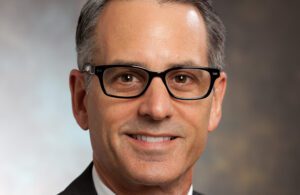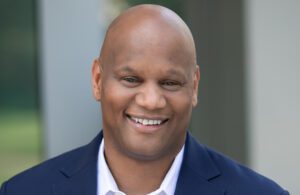
Johnson & Johnson Office of Digital Innovation Leader Peter Schulam [Photo courtesy of Johnson & Johnson ]
Cloud-connected medical devices already collect and analyze data, talk to each other and use artificial intelligence to improve patient care, but how much more might be possible in the not-so-distant future? Surgery simulations? Smart ambulances? Full-body scanners? One-click healthcare?
I’ve been exploring that question for an upcoming edition of Medical Design & Outsourcing magazine, and asked two leaders in the Johnson & Johnson (NYSE:JNJ) medical device business to put their imagination to work as they embark on a cloud partnership with Microsoft (NASDAQ:MSFT). This second part of the conversation (read the first part here) also discusses the regulatory aspect of cloud-connected medical devices and how the medtech industry can keep advancing the technology.
This conversation with Johnson & Johnson Group CIO and Global VP of Medical Devices Larry Jones and Office of Digital Innovation Leader Peter Schulam (who also serves as global head of medical affairs, clinical affairs and pre-clinical research for Johnson & Johnson Medical Devices Cos.) has been edited for space and clarity.

Johnson & Johnson Group CIO and Global Vice President of Medical Devices Larry Jones [Photo courtesy of Johnson & Johnson ]
MDO: What sort of incredible medtech technology might the cloud make possible within our lifetimes, maybe within even the next few years?
JONES: Can you simulate a surgery? Can you create a digital twin of a hospital? Can you create more personalized experience for surgery or any point of care? … If there’s an accident on the roadway and there’s trauma, shouldn’t the ambulance be the first data collection? Leveraging the cloud, leveraging IoT (the “Internet of Things”) that by the time that patient gets to the hospital, the oncoming care team is already aware of everything about that patient, has the right equipment and makes sure that patient goes to the most appropriate hospital. … Healthcare should be a lot cheaper and a lot of folks should have access to it. And I think technology can really, really help that. The art of the possible is extraordinary in a sector, quite frankly, that’s fraught with inefficiency.
SCHULAM: We were talking yesterday and Larry said, “It starts before you get to the hospital and continues when you leave the hospital.” So our vision should be to remove the walls of a hospital so that care becomes part of a continuum. And as Larry mentioned, as soon as you interact with a paramedic in the field, you should be connected to some ecosystem that starts transferring data. The electronic medical record should be available to that paramedic so they know the medical history and allergies of that patient. And as the data is acquired at the site of the trauma or the accident, that information’s immediately fed to the hospital that’s receiving that patient. It’s preemptive. Currently, we work in these points of care, these isolated nodes of activity. What we have to do is think about removing those nodes of activity and creating a continuum from before you enter the hospital to when you go home. When we talked yesterday, Larry says, “Remove the walls of the hospital. That’s only a physical structure. Digital structure is above it and continues from beginning to end.”
MDO: How does FDA regulation play into the cloud and medical devices?
JONES: There’s a lot of position statements still waiting to hear from the FDA on machine learning, artificial intelligence, even from a cyber perspective. I feel for the FDA. They can’t keep up. There’s so much coming at them. That’s where AdvaMed, other manufacturers need to collaborate to help, all — as Peter mentioned — with keeping the patient in the center of it and keeping their respective safety and privacy in front of everything. Innovation is great, but if it compromises your health or your privacy then you don’t want to do it. And it’s also being mindful that sometimes not all tech can be used for good. Sometimes tech can be used for bad.
MDO: Are there any ideas that keep you up at night with excitement, thinking about they might be possible?
JONES: This whole concept of a smart hospital and services like information management services, not just connectivity, but through a coalition of partnerships that can really transform not just the hospital. And being a Trekie, I dream of having that device that just scans you and tells you if you’re healthy or not, and we’re getting close to that with rings and watches. … I think patients are being much more open to managing their health on a regular basis. How do we leverage that to make sure they stay healthy longer, so when they unfortunately do suffer from a chronic illness or need a surgical procedure, it’s easy for them? Technology is gonna be a big component of that. I’m excited. I feel like I was kind of born to be in this space, and there’s a lot of innovation, a lot of art of the possible that I think will be realized in the next five or 10 years.
SCHULAM: As Larry mentioned, there’s a lot of friction in healthcare and we have to remove that friction. Think about the friction that was removed from retail by Amazon. It’s one click. It’s brilliant. Matter of fact, it’s almost too easy. The bottom line is if we can do that in retail, why can’t we do that in healthcare? One of the reasons it can be difficult is because, obviously, if you get delivered the wrong pair of sunglasses that you ordered, that’s OK. You have a little bit of leniency in (the retail) world. In our world: compliance, security, fidelity, we can’t afford a mistake. That’s the balance that we have to play with, but we don’t want that to lead to us being paralyzed and not moving forward. We’re a little bit more conservative in the medical arena, and then you look at the tech arena. So again, bringing those cultures together could be extremely creative. … We’re focused on being smarter, less invasive, more personalized, but our overarching thing is we need to decrease patient outcome variability and improve operational efficiency. When we look at outcomes, we think there’s two main contributors: caregiver skill and provider judgment. And I think we have the ability through our assets that we’re innovating around to actually have impact on that. And if we do that, then we really believe that patient outcome will be improved. Standard of care will be improved. I tell everyone the variability that we see, if we narrow that variability and shift that whole curve to the right, that’s a good vision.